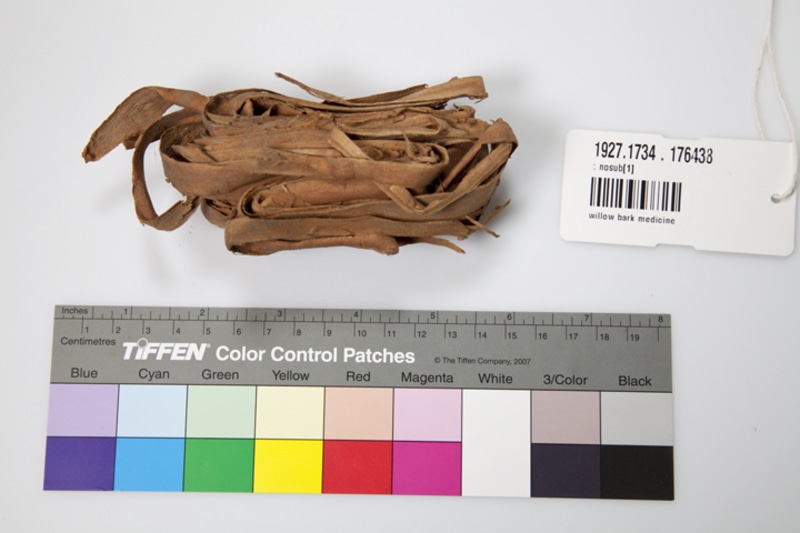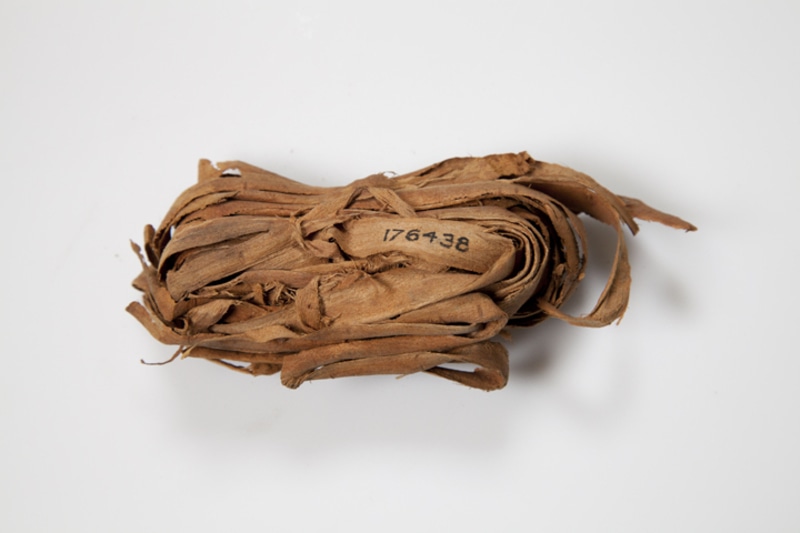willow bark medicine Item Number: 1927.1734 . 176438 from the The Field Museum




Citations From Vanstone (1982) Article
« The consulting of oracles so as to determine where and when to hunt and to know the future with reference to the weather, illness, and personal matters was extremely important to the Lake St. John Montagnais. It is a subject that has been discussed in considerable detail by Speck (1935, pp. 138-147). A more recent discussion of the subject, with a different interpretation, is found in Tanner (1979, ch. 6). »
Vanstone, James W. "The Speck Collection of Montagnais Material Culture from the Lower St. Lawrence Drainage, Quebec." Fieldiana. Anthropology. New Series, No. 5 (October 29, 1982), p.19.
« A bundle of narrow bark strips is described simply as "willow bark medicine." According to Speck (1917, p. 315), the bark of the red willow was scraped and steeped to make a mash that was put in a bandage on the head for a headache. It was also dried and smoked as a substitute for tobacco. »
Vanstone, James W. "The Speck Collection of Montagnais Material Culture from the Lower St. Lawrence Drainage, Quebec." Fieldiana. Anthropology. New Series, No. 5 (October 29, 1982), p.21.
Translation Of Citations From Vanstone (1982) Article
« La consultation des oracles, qui servait à déterminer où et quand chasser et aussi à connaître le futur, notamment en ce qui a trait aux conditions météo, aux maladies et aux questions personnelles, était extrêmement importante pour les Montagnais du Lac-Saint-Jean. C’est un sujet qui a été discuté de façon très détaillée par Speck (1935, pp. 138-147). Une discussion plus récente sur ce sujet, comportant une interprétation différente, se retrouve dans Tanner (1979, ch. 6). »
Vanstone, James W. "The Speck Collection of Montagnais Material Culture from the Lower St. Lawrence Drainage, Quebec." Fieldiana. Anthropology. New Series, No. 5 (October 29, 1982), p.19.
« Un paquet de lisières d’écorce étroites est décrit simplement comme un “ remède d’écorce de saule ”. Selon Speck (1917, p. 315), l’écorce du saule rouge était grattée et trempée pour en faire une pâte qui était mise dans un bandage sur la tête pour les maux de tête. Elle était aussi séchée et fumée comme substitut au tabac. »
Vanstone, James W. "The Speck Collection of Montagnais Material Culture from the Lower St. Lawrence Drainage, Quebec." Fieldiana. Anthropology. New Series, No. 5 (October 29, 1982), p.21.
Item History
- Made in Pekuakami, Lac Saint-Jean, Lake St. John, Labrador, Canada
What
- Name
- willow bark medicine
- Identification Number
- 1927.1734 . 176438
- Type of Item
- willow bark medicine
- Material
- willow bark
Who
- Culture
- Ilnu, Montagnais and Innu
Where
- Holding Institution
- The Field Museum
- Made in
- Pekuakami, Lac Saint-Jean, Lake St. John, Labrador, Canada
Other
- Nom De L'objet
- Remède d'écorce de saule
- Matériaux
- écorce de saule
- Ethnic Group
- Montagnais
- Collection
- Lake St. John Objects
- Provenience
- North America, Canada, Quebec, Labrador, Lake St. John